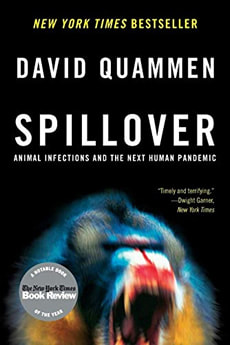Now, nearly 8 years later we have reached another momentous event in the history of Nuts & Bolts… it’s our 300th Bug Blog! But what do you write about for a 300th blog, I hear you cry? I had the same reaction!
Spillover is the term used to describe “the moment when a pathogen passes from members of one species, as host, into members of another”.
I love reading the backs of books to see what they’re about, weird I know but everyone has to have a hobby. But reading the back of Spillover makes the hairs on the back of my neck stand up!
“The next big human pandemic – bigger than AIDS or the 1918 influenza – is likely to be caused by a zoonotic virus, one that jumps from a wild animal to infect a human host. Experts call such an event a ‘spillover’, and they warn us to brace ourselves.”
Read that again and tell me you don’t have goose bumps!
The basic premise of this book is to chart the story of modern viral infection discovery, how these are caused by organisms that have crossed the species barrier, and why this will inevitably happen again resulting in a major pandemic. Oh yeah there were some (many) scientists who “knew” this pandemic was coming!
The book is divided into 9 sections covering 8 different specific zoonotic infections and finishes with a broader discussion about the future (or the present?). The viruses discussed include:
- Hendra Virus
- Ebola Virus
- Plasmodium knowlesi
- Severe Acute Respiratory Syndrome (SARS) coronavirus (the original SARS CoV)
- Coxiella burnetii (the cause of Q fever)
- Herpes B Virus
- Nipah Virus
- Human Immunodeficiency Virus (HIV)
Gosh, we have blogged already on all but the original SARS! Each section leads the reader through the story of the discovery of each organism, when and how they were discovered and by whom. The research is exhaustive, with the author travelling all over the World to speak to the key players in each story and actually visiting the sites where the action took place. The author even gets his hands dirty (figuratively and literally) in the pursuit of the facts.
I especially liked the section on HIV, where the author tracks the origins of where in the World HIV crossed over into humans, and more fascinatingly for me, when? I won’t spoil anything, but it probably isn’t when you think! There was a lot in the book I didn’t know, and I love learning new things… which I then enjoy repeating to others in the form of teaching… [although sometimes I think he enjoys this bit more than his students – ECIC, yawn, yawn, yawn].
Another highlight was the description of field work, like trying to humanely catch, sample, and release monkeys whilst hunting for evidence of Herpes B Virus. It sounds like a cross between a Carry-on film and a desperate last stand in a John Wayne movie… read the book, you’ll see what I mean.
The final section asks questions about why viruses in general jump into new species and how human behaviour and the increasing human population makes this more and more likely. It also poses the question about which viruses are likely to be the cause of the next pandemic, and I don’t think this can be deemed a spoiler…you’ve guessed it, coronaviruses are right up there at the top. Remember, this book was written in 2013, when the only “serious” coronavirus was SARS, so with that in mind the prediction made by David Quammen around coronaviruses is even more spooky (queue jaw dropping and more goose bumps!).
So, who is David Quammen?
David Quammen is an award-winning author from the USA. He has written at least 15 non-fiction books, primarily about natural history, science and travel, as well as writing articles for magazines such as National Geographic. He studied literature at both Yale and Oxford Universities, and currently lives in Montana, USA, apparently because the trout fishing is good there.
I have never met David Quammen, but he comes across in his writing as someone who you would want to talk to. Not only does he take the time to travel and speak to the experts in the field of zoonoses, but they appear ready and willing to talk to him on multiple occasions as well as take him into the field with them to “help” with their research. I like this; it makes me think he is an approachable character who both shows and deserves respect, otherwise I think these busy people wouldn’t have had the time for him.
Why should you read Spillover?
If you want a book that will make you think, make you uncomfortable, make you learn more about where infections come from and why, then this is a book for you. It is very long, 520 pages of actual text, which appears daunting at first glance (it is a doorstop sized tome), but it is actually very easy to read. Yes, there are quite a few names of organisms but if you can read the Bug Blog then you should have no trouble with Spillover.
And yes, I’m sure there may be some artistic licence and over-dramatization hidden within the pages but, as someone who has spent the past 20 years in microbiology, I couldn’t find any fact that doesn’t fit with the current body of scientific evidence, and I quite like a good story too illustrate a point!
You would also be forgiven for worrying that this is some dry microbiology textbook, impossible to read, and suitable only for those having trouble falling asleep… oh no… this is a well-crafted story, with cliff hangers and scary bits. It definitely makes for poor bedtime reading, you’ll read on “just one more chapter” and then be wide awake, aghast… though please don’t have nightmares.
In fact, reading this book, you would think that David Quammen is a modern-day Nostradamus, able to predict the future. But he isn’t. He is an author who has taken the trouble to research his subject in detail and translate it into an accessible book for everyone to read, and I really appreciate that. What he writes about is confirmed by what happened with SARS CoV2 during the past year… he and all those worried zoonotic scientists were right!
So, I wonder if there is a follow up book being planned, perhaps with the title “I told you so!” I’ll definitely queue up in a socially distanced, responsible fashion for a book like that…
Thanks for being with us and supporting Microbiology Nuts & Bolts and The Bug Blog, it’s humbling to know there are so many of you out there who read what we write. Now it’s time for the ECIC and I to celebrate being 300... Oh look ECIC has already found the Pimms!


 RSS Feed
RSS Feed
